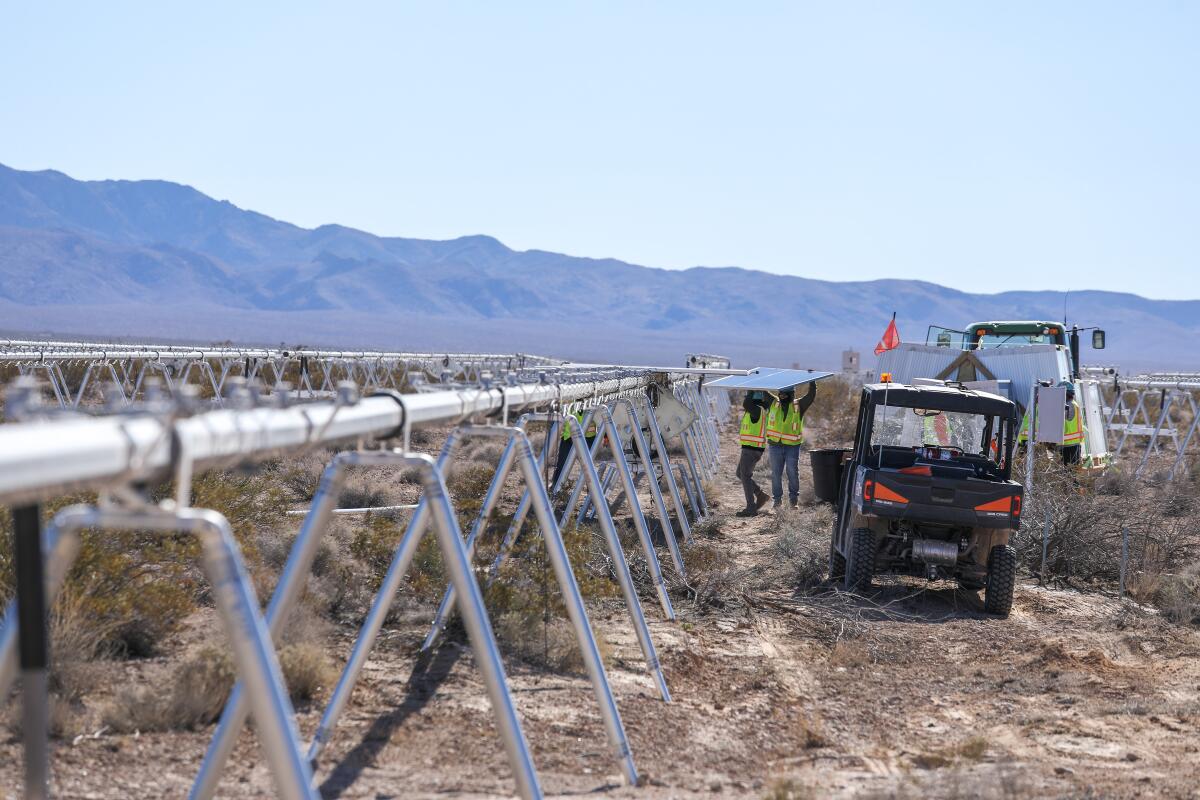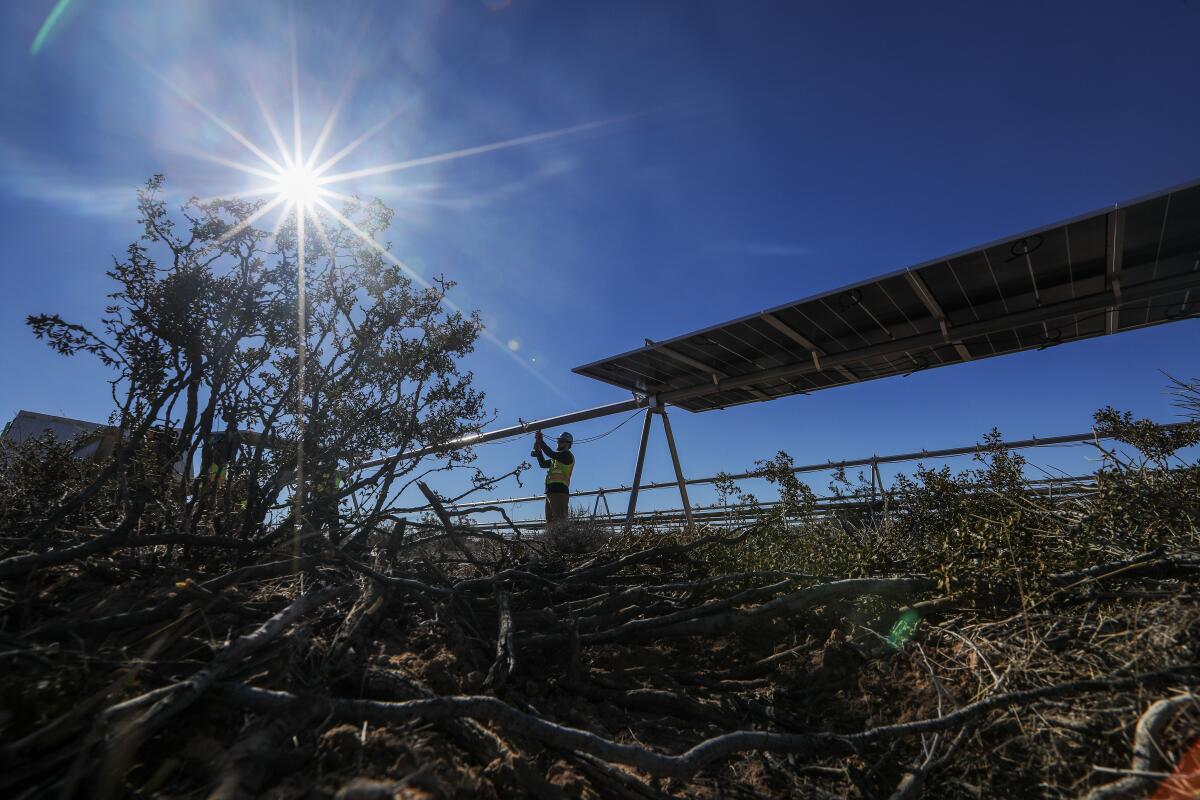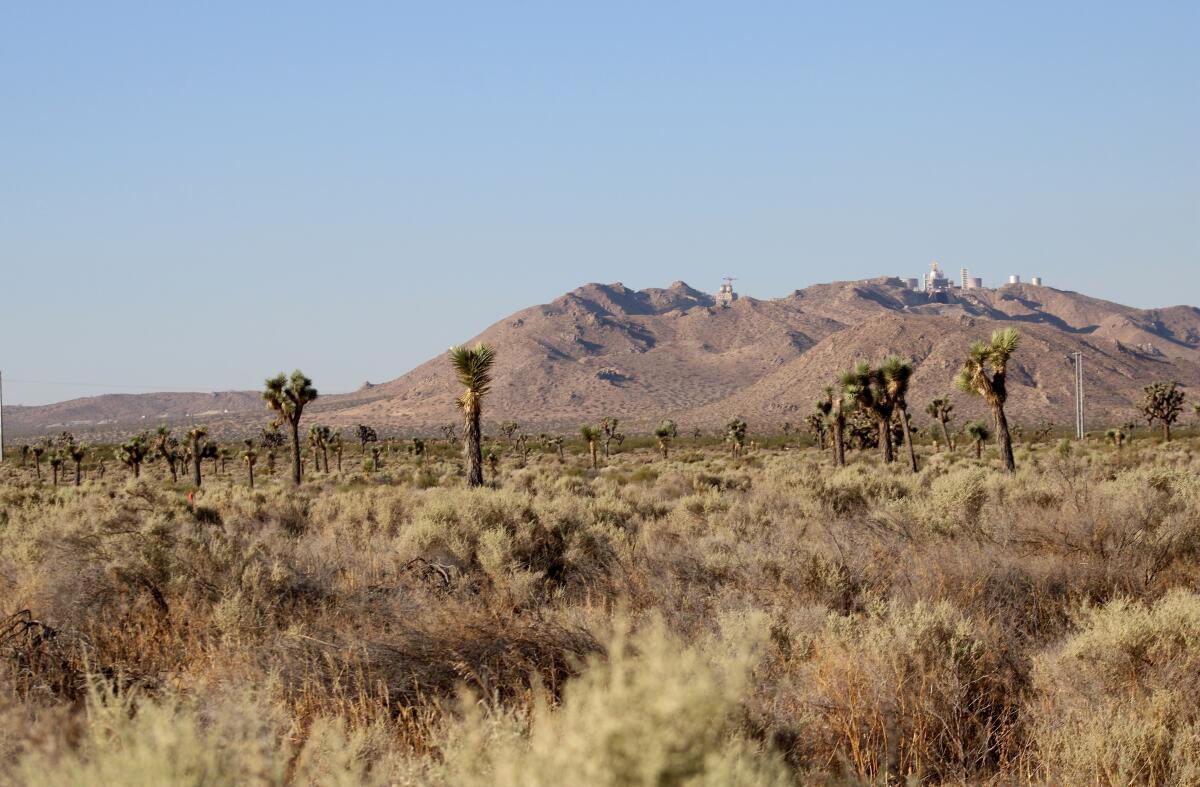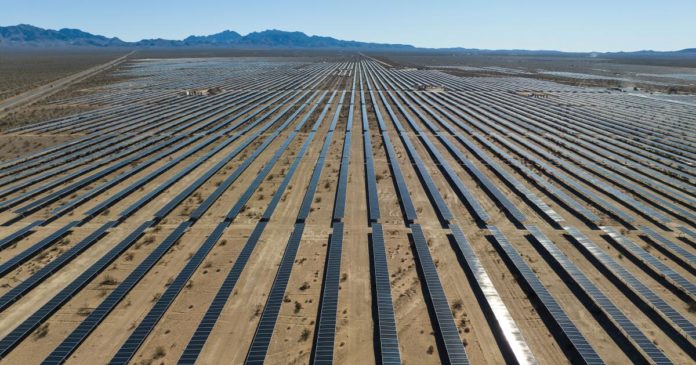Let’s say the American West could dedicate a landmass smaller than Delaware to all of the large-scale solar farms that will be needed in this part of the country to help phase out planet-wrecking fossil fuels.
Delaware covers 1.6 million acres. An estimated 1.3 million — spanning 11 states, from California to Wyoming — could eventually be developed under the Biden administration’s soon-to-be-finalized Western Solar Plan.
Most of those solar farms would be built on lands owned by the American public — lands that are often home to endangered animals, or held sacred by Indigenous tribes, or just beautiful to look at. But devoting some of those lands to solar energy would lessen the ever-deadlier heat waves, fires and storms of the climate crisis.
Newsletter
You’re reading Boiling Point
Sammy Roth gets you up to speed on climate change, energy and the environment. Sign up to get it in your inbox twice a week.
You may occasionally receive promotional content from the Los Angeles Times.
Worthwhile trade-off, right?
If only reality were so simple.
When federal officials released the solar plan in August, reactions ranged from optimistic to apoplectic.
The solar industry’s main trade group described the road map as a “step in the right direction” to help renewable energy compete with coal, oil and gas extraction on public lands. The Natural Resources Defense Council and the National Audubon Society, two of the country’s leading environmental groups, said the Biden administration had worked hard to strike a fair balance between renewable energy development and habitat conservation.
Other conservation activists weren’t so generous.
Take Patrick Donnelly, the Center for Biological Diversity’s Great Basin director and a leading critic of many solar farms planned for Nevada — some of which are designed to send electricity to power-hungry California.
Donnelly spoke for many desert lovers when he called the Biden administration’s vision a “solar apocalypse.”
“This could only be described as balance is if the desert is regarded as worthless,” he wrote on social media.

Patrick Donnelly of the Center for Biological Diversity hikes up Big Dune, 90 miles northwest of Las Vegas, in 2023. Energy companies had proposed more than a dozen solar farms on public lands surrounding the giant pile of sand.
(Brian van der Brug / Los Angeles Times)
The tension between renewable energy and landscape conservation has been building for years.
It started in the California desert in the early 2010s, when Obama-era stimulus funds helped fuel a solar building boom. The sprawling facilities stirred controversy from the start, with some conservationists saying badly located projects destroyed precious habitat for desert tortoises, fringe-toed lizards, bighorn sheep and other wildlife.
Now the solar boom has spread to other states. So has the controversy.
It’s a damn-near-impossible balancing act for President Biden’s appointees as they seek to dramatically grow the nation’s renewable energy capacity and expand the power grid to enable 100% clean electricity in the next dozen years. That’s what scientists say is needed to avoid the most dangerous consequences of climate change.
Tracy Stone-Manning, who leads the U.S. Bureau of Land Management, said in a written statement that Biden’s Western Solar Plan would “drive responsible solar development to locations with fewer potential conflicts.”
Is she right?
One sticking point for critics is the huge amount of land the plan would open to solar projects.
Although officials estimate that just 700,000 acres overseen by the Bureau of Land Management would actually be covered in solar panels over the next 20 years — plus another 280,000 acres already open to solar on bureau lands in California — Biden would make a whopping 31 million acres of public land available to developers.
If we only need 1 million acres of development, why open up 31 million?
Solar companies say greater flexibility helps them find sites that are financially viable.
Inevitably, some development zones will have unexpected wildlife conflicts. Others will face political opposition from rural towns that don’t want energy projects nearby. Some solar companies will choose locations based on planned power lines that end up not getting built, leaving them with no way to sell their electricity.

Naturalist Lisa LaVelle checks out a desert tortoise at Desert Tortoise Research Natural Area in California City in 2022.
(Irfan Khan / Los Angeles Times)
If anything, some companies worry the Western Solar Plan would unduly restrict development.
Peter Weiner, a San Francisco lawyer who represents solar firms, believes the plan may contain serious technical and legal errors, such as misclassifying certain areas as valuable tortoise habitat and penalizing solar developers for following faulty instructions from federal officials — potentially leading to project cancellations in Nevada.
The solar industry is still relatively new and hugely competitive, Weiner added, with a lot of companies competing for capital. If investors see too much risk — changing regulations, canceled projects — they may jump ship.
“This is not like Exxon, who says, ‘We don’t care, it’s $100 million, so what,’” Weiner said.
Federal officials tried to limit ecosystem damage by prohibiting solar applications across 130 million acres. They barred development on critical habitat for endangered species, as well as recreation areas, scenic byways, lands with wilderness characteristics, big game migratory corridors and other sensitive places. Officials also told solar firms they can’t build farther than 15 miles from existing or planned electric lines, with a few exceptions.
These are the right ideas. The challenge is putting them into practice.
In the same way solar developers insist federal officials have excluded ideal spots to build, conservationists swear the Biden administration is planning to sell off some of the nation’s most ecologically sensitive acreage.
Much of the debate centers on Nevada, which has more federal land than any state besides Alaska.
At a solar industry conference in Anaheim last month, Biden’s national climate advisor, Ali Zaidi, told attendees he had just visited one of the country’s largest solar farms: the Gemini project, on federal land outside Las Vegas. He lauded “the partnership with [federal officials] to build with nature as opposed to in conflict with it.”
As it happens, I also visited Gemini last year, during construction. The developers did in fact take innovative steps to limit harm to plants and animals, such as leaving some native vegetation in place and installing steel trusses of different heights to match the ground’s natural contours, rather than leveling all the land flat.

Construction workers carry photovoltaic panels for installation at the Gemini solar project in southern Nevada in 2023.
(Brian van der Brug / Los Angeles Times)
Those actions make Gemini a great example of balancing solar and conservation — in theory.
In practice, the Bureau of Land Management only approved Gemini after the bureau’s local staff contemplated rejecting the project. As I reported last year, the agency’s Las Vegas office originally drafted a “record of decision” that denied the permit application, citing harm to desert tortoises and loss of space for off-road vehicle drivers.
These are hard choices. Maybe you personally don’t care about tortoises or off-roading. But somebody does.
So when I asked Zaidi how to judge whether the Western Solar Plan is a success, I didn’t love his one-dimensional answer: “Projects get built.” Yes, we need solar projects to get built, or the habitable climate that supports human life will keep breaking down. But how can we judge the plan’s success without considering conservation?
Sure, 130 million acres will be protected from solar. But the challenge is, nobody can agree on all the places that need protection. That won’t change in the next few months, as federal officials finalize the Western Solar Plan.
Large solar fields aren’t the only way to power society without heat-trapping coal, oil and natural gas.
But even though energy experts say we’ll need a diverse set of technologies to replace fossil fuels — with rooftop solar systems an important piece of the puzzle — large-scale solar is one of the world’s cheapest, fastest-growing forms of renewable energy. And time is short to get the climate crisis under control. Scientists say meeting global climate targets will require cutting carbon pollution more than 40% by 2030 — just six years from now.
The best time for a drawn-out debate about where to build solar and where to prohibit development would have been 25 years ago. Alas, climate denial campaigns led by fossil fuel companies robbed us of that option.
As Zaidi told me, “We have a constrained set of options because of our decades-long delay on the climate crisis.”
We should still do our best. Biden’s Western Solar Plan, while far from perfect, is a good-faith effort.
And to the extent solar companies can find ways to coexist more peaceably with nature, even better.
Gemini was a good start. The way the developers followed the ground’s natural contours, instead of leveling the land beneath each row of panels? That was made possible in part by Array Technologies, the Albuquerque-based company that supplied the tracking devices, which allow the panels to follow the sun across the sky.

Native vegetation remains in place at the Gemini solar construction site, where panels track the ground’s natural contours.
(Brian van der Brug / Los Angeles Times)
Array adapted its technology for Gemini — not a cheap or easy task. But since then, the company has developed terrain-following trackers that it says can save developers money in earthworks and permitting costs.
There’s no getting around the fact that solar projects are industrial intrusions on public lands. But in the absence of easy answers — or a few decades to find those answers — solar sprawl is better than climate chaos.
As I mentioned earlier, some of the fiercest battles are playing out in Nevada, where dozens of solar farms are proposed on public lands (and several big ones are already built). Here’s a view from the ground:
- Federal officials approved a 350-mile power line between Las Vegas and the Reno area that would fuel lots of solar development. It’s proposed by Warren Buffett’s NV Energy. (Amy Alonzo, the Nevada Independent)
- Biden’s Western Solar Plan would open 11.8 million acres to possible development statewide. (Amy Alonzo)
- Esmeralda County, home to 750 people, could host a cluster of solar projects spanning 62,000 acres. There’s been huge local opposition. Similar conflicts are playing out in rural Western communities. (Amy Alonzo)
- Several tribes are worried that Biden’s solar plan, if finalized, could threaten their proposed Bahsahwahbee National Monument, site of 19th century massacres of Native Americans. (Jeniffer Solis, Nevada Current)

Dozens of Joshua trees are shown across the Mojave Desert landscape before tree-cutting crews working for Avantus arrived in late August. The company is building the Aratina Solar Center.
(Roy Richards)
There’s been plenty of solar controversy in California, too:
- A developer has been shredding thousands of Joshua trees to make way for a Mojave Desert solar farm, to the extreme consternation of nearby residents in Kern County. (Melody Petersen, Los Angeles Times)
- Are solar developers living up to their commitments to plant and maintain native vegetation for pollinators? In at least one project near Sacramento, the answer is a resounding “no.” (Catrin Einhorn, New York Times)
- Even along Interstate 10 east of Palm Springs, where the big solar boom began, “No one wants to really see these in their backyards,” Riverside County Supervisor V. Manuel Perez says. (Janet Wilson, the Desert Sun)
Lastly: For a less encouraging take on Biden’s solar plan than the one I offered above, see this analysis by environmental journalist Jonathan P. Thompson. His criticism: “You’re likely to get a sprawling hodgepodge of massive solar installations scattered across the desert rather than all concentrated in a few places.”
This is the latest edition of Boiling Point, a newsletter about climate change and the environment in the American West. Sign up here to get in your inbox. Or open the newsletter in your web browser here.
For more climate and environment news, follow @Sammy_Roth on X.


